Clear aligners have emerged as a popular and comfortable alternative to traditional braces, offering a discreet solution for achieving a straighter smile.
These custom-made, transparent plastic trays fit snugly over your teeth, gradually guiding them into the desired position.
Unlike braces, clear aligners are removable, adding to their comfort and discretion.
A common question that arises is, “Can you sleep with clear aligners?”
The answer is a nuanced “Yes”, but it depends on various factors.
In this guide, we will delve into the safety of sleeping with clear aligners, addressing common concerns, and providing tips for a comfortable experience.
Here are some key points we will cover:
- Pros and Cons: We will explore the advantages and potential challenges of sleeping with clear aligners.
- Types of Clear Aligners: We will discuss the different types of clear aligners and how they might affect your sleep quality.
- Tips for Comfort: We will share some tips on how to sleep comfortably with clear aligners and achieve the best results for your smile.
By understanding these aspects, you can make an informed decision about whether clear aligners are the right choice for you. Stay tuned for more insights and advice on this topic.
Table of Contents
ToggleWhy Choose Clear Aligners
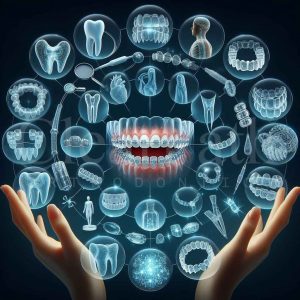
Before we delve into the specifics of sleeping with clear aligners, let’s first understand their appeal. Clear aligners bring several advantages to the table, making them a preferred choice for many.
Here are some key benefits:
Discretion, Comfort, and Removability
However, it’s important to note that for effective treatment, clear aligners must be worn consistently, including during sleep.
This consistent wear time is crucial to achieving the desired results.
Advantages Over Traditional Braces
Clear aligners offer a host of benefits over traditional braces, making them a preferred choice for many.
Here are some key advantages:
| Why Aligners are Preferred over Braces | Crafted from smooth plastic, clear aligners are gentle on your gums and cheeks, and devoid of any sharp edges or corners that could cause discomfort. |
| Discretion | With their virtually invisible design, clear aligners allow you to smile confidently, free from the worry of noticeable metal wires or brackets. |
| Comfort | Crafted from smooth plastic, clear aligners are gentle on your gums and cheeks, devoid of any sharp edges or corners that could cause discomfort. |
| Removability | One of the standout features of clear aligners is their removability. This allows you to enjoy your favorite foods and drinks without restrictions and maintain optimal oral hygiene throughout your treatment. |
| Effectiveness | Clear aligners are capable of treating a wide range of orthodontic issues, including crowding, spacing, overbite, underbite, crossbite, and open bite. In some cases, they can even deliver faster results than braces. |
However, it’s important to note that using clear aligners requires a significant level of commitment and responsibility on the part of the wearer.
Preferable Wear Time
When it comes to the optimal wear time for clear aligners, consistency is key. For the best results, they should be worn for at least 20 to 22 hours each day.
This includes both daytime and nighttime, with exceptions only for meals and oral hygiene routines.
It’s important to note that any deviation from this schedule could potentially compromise the effectiveness of your treatment and extend its duration.
Therefore, commitment to the recommended wear time is crucial for a successful orthodontic journey with clear aligners.
Sleeping with Clear Aligners (Pros & Cons)
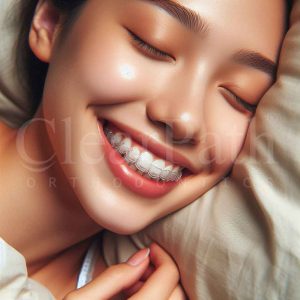
Sleeping in clear aligners is not only possible but also beneficial for some people.
Here are some of the pros and cons of sleeping with clear aligners:
Pros
These are some of the things aligners offer over braces.
| How Aligners are better than braces |
| Maximizing Wear Time: Wearing clear aligners during sleep allows for uninterrupted application of pressure on your teeth, ensuring they move into the desired position effectively. |
| Convenience: With clear aligners, there’s no need to worry about removing and reinserting them around bedtime. You can simply go to sleep and wake up with your aligners in place. |
| Protection Against Teeth Grinding: If you’re prone to bruxism (teeth grinding), clear aligners can serve as a protective barrier during sleep, helping prevent enamel erosion, tooth sensitivity, and jaw pain. |
Cons
While clear aligners offer numerous benefits, it’s also important to be aware of the potential challenges.
Here are some points to consider:
| Challenges with Clear Aligners |
| Initial Discomfort: The first few days or weeks of treatment may bring some discomfort. You might experience soreness, pressure, or tightness in your teeth and gums as they adjust to the new trays. This could temporarily affect your sleep quality and comfort. |
| Increased Saliva Production: Some individuals may notice an increase in saliva production when sleeping with clear aligners, leading to potential drooling. However, this is usually a temporary issue that resolves as your mouth adapts to the trays. |
| Swallowing/Choking Risks: Although rare, there is a potential risk of swallowing or choking on the aligners, especially if they are loose or ill-fitting, or if you have certain sleeping habits such as sleeping on your stomach or with your mouth open. To mitigate this risk, ensure your trays fit securely and try to maintain a sleeping position that doesn’t dislodge them. |
Addressing Common Concerns and Questions
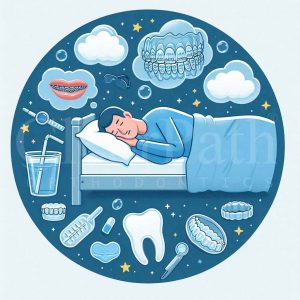
Is it safe to sleep with clear aligners?
Absolutely, but it’s crucial to maintain proper care and hygiene. Regular cleaning of your aligners and good oral hygiene practices are essential to minimize any potential risks.
Will it be uncomfortable?
It might take some time to adjust. To enhance your comfort, consider elevating your head while sleeping and opting for comfortable sleepwear.
What if I accidentally swallow an aligner?
Don’t panic. Immediately reach out to your orthodontist for guidance. They can provide you with the necessary advice and next steps.
Is it safe to sleep with clear aligners?
Indeed, it is safe to sleep with clear aligners, provided you adhere to proper care and hygiene guidelines.
Here are some tips to ensure your aligners remain clean and safe throughout the night:
| Oral Hygiene Tips with Clear Aligners | Description |
| Pre-Bedtime Oral Hygiene | Brush and floss your teeth before wearing your aligners. This prevents food particles and bacteria from being trapped between your teeth and aligners, thereby avoiding plaque buildup, cavities, bad breath, and gum disease. |
| Rinse Before Use | Rinse your aligners with water before putting them on to remove any dust or debris that may have accumulated during the day. |
| Regular Cleaning | Clean your aligners regularly using a soft toothbrush and mild soap or denture cleaner. Avoid using hot water or abrasive products that could warp or damage your aligners. |
| Proper Storage | When not in use, store your aligners in a case to protect them from dirt, dust, bacteria, and pets. |
Will it be uncomfortable?
Adjusting to sleeping with clear aligners might initially be a bit uncomfortable, but rest assured, it gets easier as your mouth adapts to the trays.
Here are some tips to enhance your comfort:
Elevate Your Head: Using a pillow or wedge to elevate your head can alleviate pressure on your teeth and gums, and improve blood circulation and breathing.
Opt for Comfortable Sleepwear: Soft, breathable sleepwear can help you stay cool and comfortable throughout the night, preventing any irritation from the trays.
Use a Humidifier or Nasal Spray: These can help moisten your airways, preventing dryness or congestion that might affect your breathing or swallowing with the trays.
Consider Over-the-counter Pain Relievers: If you experience significant or persistent discomfort from the trays, over-the-counter pain relievers like ibuprofen or acetaminophen can help. However, always adhere to the recommended dosage and frequency, and consult your doctor if you have any medical conditions or allergies.
What if I accidentally swallow an aligner?
In the unlikely event that you accidentally swallow an aligner, don’t panic. Aligners are typically harmless if ingested. However, it’s crucial to take immediate action and contact your orthodontist.
Here’s what you can do:
| How to Avoid Injury | Description |
| Attempt to Cough It Up | If you feel the tray in your throat, gently try to cough it up. Avoid forcing it or sticking your fingers in your mouth, as this could push it further down or cause injury. |
| Hydrate | If coughing doesn’t work, drink some water to help it slide down your esophagus and into your stomach. Avoid carbonated or acidic beverages, as they may irritate your throat or stomach. |
| Reach Out to Your Orthodontist | Inform your orthodontist about the incident and seek advice. They may ask you to monitor your symptoms and wait for the tray to pass naturally through your digestive system, which could take a few days. They might also prescribe a new tray or adjust your treatment plan. |
| Seek Medical Attention | If you experience any signs of obstruction, infection, or perforation, such as difficulty breathing, swallowing, or speaking, chest pain, abdominal pain, vomiting, fever, or blood in your stool, seek immediate medical attention. |
Choosing to sleep with clear aligners is a personal decision that depends on your comfort level and treatment goals.
While there are pros and cons, the key is to follow your orthodontist’s instructions and wear them for the prescribed time.
Different Clear Aligner Types and Sleeping
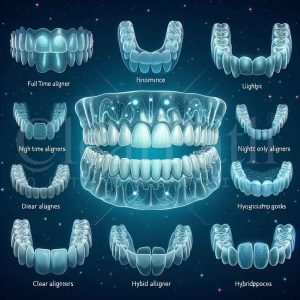
There are different types of clear aligners available in the market, and they have different implications for your sleep. Here are some of the most common ones:
- Full-Time Aligners
- Nighttime-Only Aligners
- Hybrid Approaches
Full-time aligners
Full-time clear aligners, the most common type, necessitate a minimum wear time of 22 hours a day, including sleep hours. This consistent wear ensures efficient and steady movement of your teeth throughout the treatment.
Additionally, wearing these aligners while sleeping aids in preventing your teeth from reverting to their original position.
However, it’s worth noting that some individuals might initially find sleeping with full-time aligners slightly uncomfortable. Initial symptoms may include soreness, dryness, or irritation in the mouth or gums. But rest assured, these symptoms typically subside as one adjusts to the aligners.
Nighttime-only aligners
Nighttime-only clear aligners are a relatively innovation. They require just 10 hours of wear per night, typically during sleep. These aligners are designed for individuals with mild to moderate teeth misalignment who prefer greater flexibility during the day.
However, it’s important to note that nighttime-only aligners come with certain limitations compared to full-time aligners:
- Longer Treatment Duration: As your teeth move less during the night than during the day, the treatment may take longer to complete.
- Limited Effectiveness: They might be less effective for complex cases or for individuals who tend to grind their teeth at night.
- Potential for Daytime Shifting: Without a retainer or similar device worn during the day, there’s a risk that your teeth may shift.
In conclusion, while nighttime-only aligners offer certain advantages, they also have specific considerations to keep in mind.
Hybrid approaches
Hybrid aligners offer a blend of daytime and nighttime options, allowing you to tailor your treatment plan to your specific needs and lifestyle.
For instance, you might start with full-time aligners for the initial months of your treatment, then transition to nighttime-only aligners for the remaining duration. Alternatively, you could wear daytime aligners during the week and switch to nighttime aligners for the weekends.
This hybrid approach provides added flexibility and convenience. However, it does necessitate more communication and coordination with your orthodontist. It’s crucial to meticulously follow the instructions and schedule to prevent any complications or delays in your treatment.
Tips for Sleeping Comfortably with Aligners
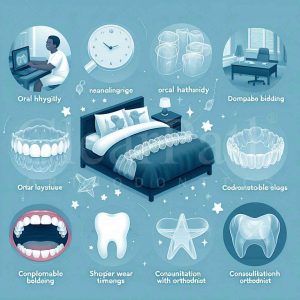
Sleeping with clear aligners, regardless of the type, can initially be a bit challenging. However, there are strategies to make this experience easier and more comfortable.
Here are some tips:
| Regime for Sleeping, while wearing Clear Aligners | Description |
| Maintain Good Oral Hygiene | Brushing and flossing after wearing your aligners is crucial for optimal dental health. |
| Consider a Mouthguard for Grinding | If you tend to clench your teeth at night, a mouthguard can help protect both your aligners and teeth. |
| Invest in Comfortable Bedding | Opt for soft pillows and breathable blankets to minimize pressure points and enhance your comfort. |
| Gradual Adjustment | Start by wearing your aligners for shorter periods during sleep, and gradually increase the duration for a smoother adjustment. |
| Keep Communication Open with Your Orthodontist | Don’t hesitate to share any concerns with your orthodontist and seek personalized advice for a comfortable experience. |
Practice good oral hygiene
Maintaining a clean and healthy mouth is crucial for a comfortable experience with clear aligners, especially during sleep.
Here’s what you can do:
Brush and Floss Regularly: Make it a habit to brush and floss your teeth every night before putting on your aligners. This simple routine can prevent food particles or bacteria from getting trapped between your teeth and aligners, thereby avoiding potential issues like cavities, bad breath, or infections.
Ensure Comfort: A clean mouth also contributes to the comfort of wearing aligners, reducing the likelihood of irritation to your mouth or gums.
Use a mouthguard for grinding
If you’re dealing with bruxism or nocturnal teeth grinding, incorporating a mouthguard into your routine alongside clear aligners could be beneficial.
Over time, teeth grinding can lead to damage to both your aligners and teeth, and may result in headaches, jaw pain, or tooth sensitivity.
A mouthguard can offer protection to your aligners and teeth from the excessive pressure and friction during sleep, and may also help alleviate the noise and discomfort associated with grinding.
However, it’s important to note that not all mouthguards are compatible with clear aligners. Therefore, it’s crucial to consult with your orthodontist before opting for one.
Invest in comfortable bedding
Enhancing your sleep quality while wearing clear aligners can also be achieved by ensuring your bedding is both comfortable and supportive.
Here are some tips:
| How to Make Your Treatment Comfortable | Description |
| Soft Pillows and Breathable Blankets | These can help minimize any pressure points or discomfort on your face or body. |
| Mindful Sleeping Position | Avoid sleeping on your stomach or side as these positions can exert additional pressure on your mouth or jaw. Instead, consider sleeping on your back or slightly elevated with a wedge pillow. |
| Manage Swelling or Inflammation | The aforementioned sleeping positions can also help reduce any potential swelling or inflammation in your mouth or gums caused by wearing clear aligners. |
Start with shorter wear times
If you’re new to the world of clear aligners, it might be beneficial to start with shorter wear times during the night until you acclimate to them.
You could begin by wearing them for just a few hours initially, then gradually extend this duration until you meet the recommended wear time.
This approach can help you adapt to the sensation and fit of the aligners, while also minimizing any potential soreness or discomfort. If needed, consider using over-the-counter pain relievers or ice packs to alleviate any pain or inflammation in your mouth or gums.
Communicate with your orthodontist
Finally, remember that your orthodontist is there to support you throughout your journey with clear aligners.
If you have any questions or concerns about sleeping with your aligners, don’t hesitate to reach out.
We can provide you with additional tips and advice for a comfortable sleep, monitor your progress, and make necessary adjustments to your treatment plan.
We’re also equipped to address any issues that may arise during your treatment, such as broken or loose aligners, unexpected tooth movement, or infections.
Your orthodontist is your partner in achieving a beautiful and healthy smile, so feel free to seek their help whenever needed.
Sleeping with clear aligners might initially present a challenge, but the rewards are significant. Not only can it expedite your teeth alignment process, but it also helps maintain good oral hygiene and prevent any dental issues that could affect your treatment.
By following the steps mentioned above, you can ensure a comfortable sleep with your aligners and reap the benefits of a healthier, straighter smile.
If you’re interested in embarking on your orthodontic journey with ClearPath, please fill out the private contact form below.
The convenience and protection against teeth grinding are notable benefits. However, experiences may vary, and comfort should be a priority.
Always consult with your orthodontist for personalized solutions.
If you’re ready to start your clearpath orthodontic journey, feel free to reach out via the private contact form provided below.











